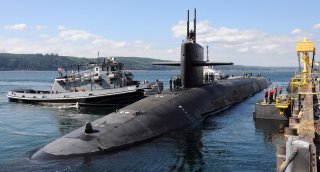The Navy's New Columbia-Class Submarines are on Track to Deploy in 2030
The first submarine has been under construction since 2020, and the Navy’s Columbia-class acquisition effort recently won an award for exemplary performance.
The U.S. Navy’s ballistic missile submarines are secretly lurking the depths of the ocean in an unknown location. Their mission is to prevent a nuclear attack on the United States by sending a message to potential adversaries that any nuclear strike would be met with a devastating counterattack.
This will be the mission for the Navy’s next-generation Columbia-class ballistic missile submarines. They are expected to carry out their first patrols in 2030.
The Columbia-class submarines have now been under development for more than a decade. They are intended to replace the existing Ohio-class ballistic missile submarines with a new generation of technology designed to ensure a potential adversary does not contemplate a first-strike nuclear attack on the United States.
The first submarine has been under construction since 2020, and the Navy’s Columbia-class acquisition effort recently won an award for exemplary performance.
The Navy has been working with General Dynamics Electric Boat and its industry partners for many years to conducting research and begin to build the boats’ modules. A technique called “tube-and-hull” forging began many years ago, a process which involved welding four missile tubes together to insert them into the structure of the submarine.
The arrival of Columbia submarines could not come soon enough, as the existing Ohio-class submarines have already been extended for years beyond their anticipated service life. The undersea leg of the nuclear triad is considered vital to the U.S. strategic deterrence effort; it is nearly impossible to find and track the submarines while at sea.
The Columbias are built with a “life-of-core” nuclear reactor, meaning it will not need to come back to dock for a lengthy refueling overhaul during its service life. This greatly extends mission operational time and deployment continuity, so 12 Columbia class submarines are expected to perform the mission of 14 Ohio-class ballistic missile submarines.
The submarines will be armed with upgraded Trident II D5 nuclear missiles and incorporate several technologies built into the Navy’s newest Virginia-class attack submarines. Some of these advancements include “fly-by-wire” navigational systems that allow precise speed and depth to be monitored and automated by a computer systems. The boat will also use a fiber-optic cable and communications systems so sailors will be able to view images from a periscope anywhere else in the ship. A sailor will not need to stand directly below the periscope to see its field of view but will be able to see it from somewhere else inside the ship.
Kris Osborn is the defense editor for the National Interest. Osborn previously served at the Pentagon as a Highly Qualified Expert with the Office of the Assistant Secretary of the Army—Acquisition, Logistics & Technology. Osborn has also worked as an anchor and on-air military specialist at national TV networks. He has appeared as a guest military expert on Fox News, MSNBC, The Military Channel, and The History Channel. He also has a master’s degree in Comparative Literature from Columbia University.
Image: U.S. Navy Flickr.

